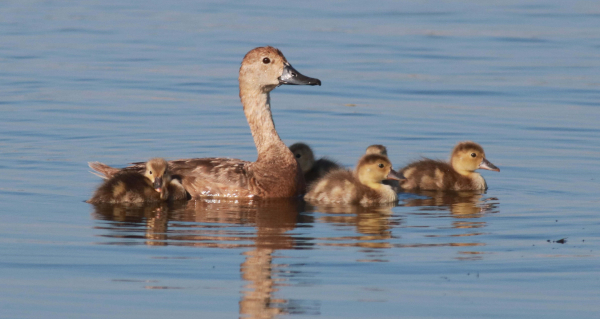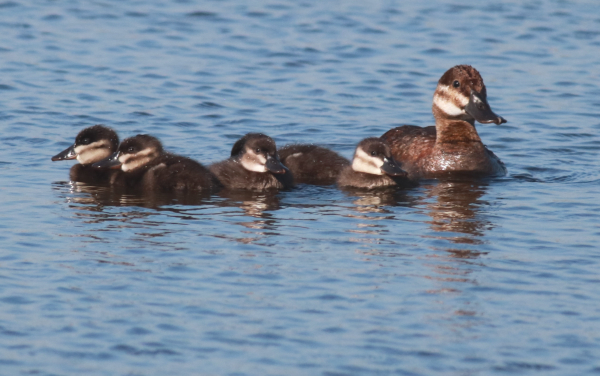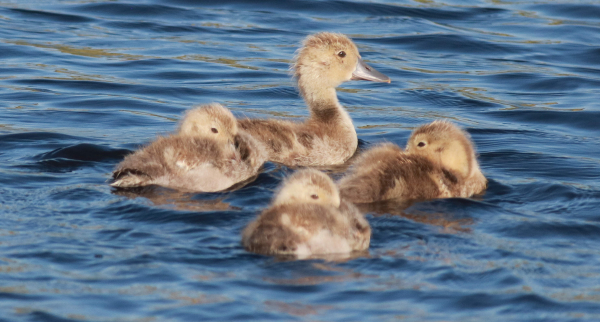I originally planned to share some insights into my most common bird photography activities during this period of the summer – photographing broods of downy ducklings led by their attentive hen. I’m lucky to live in the middle of the best duck nesting range in the continental United States, but wherever you live there are ducks to photograph, including broods of ducklings. Before I get to the technical side of photographing duck broods, permit me to share the lead-up to this article:

I was excited to write an article about how to get the most out of photographing ducks, especially females with newly hatched ducklings, and planned to illustrate the article with a few photos I’ve taken this season and last. Then, Wednesday afternoon I found a diving duck oasis where I was surprised to see two beautiful Redhead broods, about a week apart in age, and a newly hatched brood of Ruddy Ducks in a single pond – along with two new Gadwall broods, and a much older Mallard brood. That’s when my plans changed a bit and I decided the photos I took Wednesday would be featured in this article.
I have never had very good luck getting photos of a Redhead brood, but all that changed then and there. The two Redhead broods were very special, and provided my first quality photos of the cute yellow ducklings – one brood had hatched just a couple days before, and the second brood was in their second week of life. The hen with the days-old ducklings was special too, she was regal and strong, and didn’t budge when I warily approached. In the same overflowing wetland, I photographed the other duck broods too, including a very cute image of three of the older, very downy Redheads napping in the sun with one more positioned alert and fuzzy.

The Ruddy Duck brood provided equally special observations and photos. The little Ruddy Ducks were fun to study at close range as they dived enthusiastically into the shallows to instinctively feed on their own not so many hours after popping out of their eggs. One moment the female was surrounded by little black ducklings, and in a moment none were in sight – they were below water in a diving search for food – then bloop, bloop, bloop, they buoyantly popped back atop the calm blue sheet of water.
The above descriptions share the birding side of photographing duck broods, but on the technical side, as always the timing, lighting, and windless weather all added to the photo opportunities provided during this exceptional duck photography event. The timing tied in closely with the beautiful late afternoon light playing on the still water, and it also related to the prime feeding time of the ducklings. Calm wind provided still water, best for feeding ducklings and it provided a pristine blue glass-like water surface. I couldn’t have ordered a better setting for the ducks to appear in.

The surprising concentration of young broods of ducks and the diversity of late-nesting species made this a very special hour, but I also realized the short-term potential of this opportunity as the sun’s angle was reduced, or if the wind came up, or if a raptor decided to hunt the area. The tranquil scene could all change in a moment. So it’s necessary to grasp such an opportunity and milk it for all you can when you find yourself there.
There were, however, some extenuating circumstances: When I found the broods, I was already running late for a social meeting, and my van had a nearly flat tire that began losing air an hour earlier. These factors added a bit of tension to the fun of such a fulfilling photo opportunity, but I texted my friend to explain the need to push our dinner time back an hour, and re-inflated my tire every 20 minutes with the portable tire inflator in my emergency road kit – small diversions considering the wonderful photo opportunities before me.
So when photographing duck broods, as always when photographing any birds, keep the sun at your back, use an ample depth of field (f8 to f11) because the duckling tend to get a bit spread out, and ensure that you’re using an adequate shutter speed as you photograph (1/500 second or faster is best). As much as anything though, take as many photos as possible when you are in position and in the moment. The fast movements of the attentive female – multiplied by the turning heads of 5 or 10 different ducklings, makes getting the best possible photo(s) difficult, so take as many photos as you deem adequate; then you can use your photo editing skills when you’re home. But when you’re in the moment, don’t hesitate to exercise that camera trigger finger – it’s better to take too many photos than not enough.

In addition to the duck and duckling movements, if there is a wind, it will create ripples or even waves on the water that will further complicate photo quality. The rippling effect on the water not only can affect the positioning of the ducklings, but it can also change the colors and texture of the water that will make your photo editing process more interesting or a little frustrating.
When they are feeding, ducklings tend to spread out, making depth of field a bigger factor, and in the case of diving ducks, it may mean they are constantly diving out of sight below the water surface. The ducklings tend to be closer to one another and the female when they are moving from one location to another – out of cover or into it, for instance. It’s easiest to get all the ducklings in the photo frame, and in focus, when they are moving close together in a compact group. Even so, you can always focus on one or more ducklings, preferably those in the foreground, or a few ducklings surrounding the hen when you have such options.
Ultimately, photograph different species of ducklings – feeding, preening, napping, diving, swimming – and record different age groups as you encounter more and more broods, or the same broods over time. Overall, relax, and enjoy the show, and photograph in all the ways in which you are inspired.
Article and photographs by Paul Konrad
P.S. I also wanted to share that two of my favorite Spanish words are patos and patitos, the words for “ducks” and “ducklings.” I find the Espanol words rather endearing and light-hearted. Enjoy any pato encounters you may have! – PK
Share your bird photographs and birding experiences at editorstbw2@gmail.com